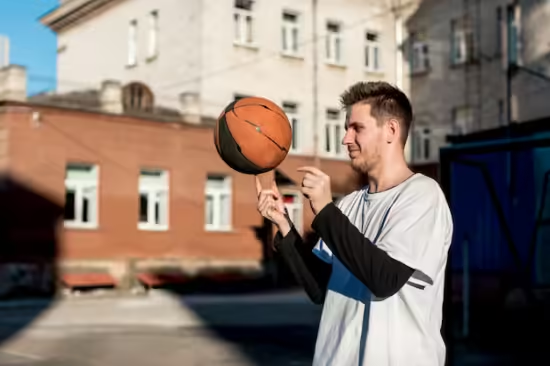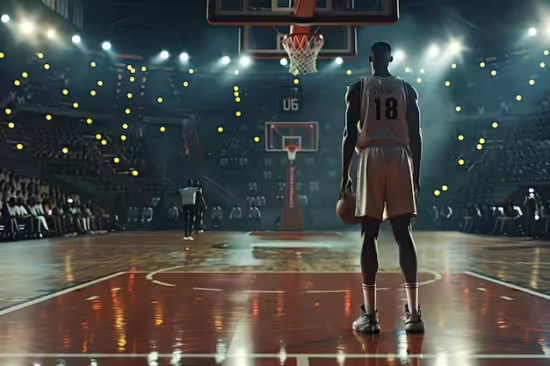How Long Is an NBA Basketball Game – An NBA basketball game is 48 minutes long and divided into four 12-minute quarters. While it may seem simple, the actual time commitment of watching an NBA game goes much further. A typical NBA game takes about 2 to 2.5 hours from start to finish.
This extended duration results from various factors, including timeouts, halftimes, fouls, and commercial breaks, which significantly increase the game’s length.
For fans, understanding the game time breakdown is key to fully understanding why an NBA game is much longer than its 48-minute playing time. Coaches use timeouts for strategic discussions and for players to rest, which can extend the game.
Halftime, the 15-minute break between the second and third quarters, provides respite for players and fans. Commercials during televised games also add to the total time.
Additionally, time limits such as fouls and free throws slow the game down, especially in close games where fouls become a deliberate strategy in the final minutes. Instant replay and official reviews add time, especially as key moments are scrutinized to ensure the correct call is made.
Although less common, overtime occurs when a match is tied at the end of regulation and an extra 5 minutes are added. Unlike other basketball formats, such as college or international games.
NBA games are among the longest in total game time. Whether you’re in the arena or watching from home, it’s important to remember that while the game clock reads 48 minutes, the experience usually lasts much longer. The NBA game is designed to keep fans engaged for hours, from start to finish, full of action and fun.

Official NBA Game Time Structure
The NBA’s official game structure consists of four quarters, each lasting 12 minutes, for 48 minutes of playing time. However, this regulated playing time does not include stoppages and other events that increase the total length.
The 48 minutes of play are divided into two halves, with a 15-minute break between the second and third quarters. Halftime is a key rest for players and allows coaches to adjust strategies. Fans in the arena and at home also enjoy halftime entertainment that adds to the spectacle but extends the game’s length in real-time.
In addition to four quarters, games tied at the end of regulation go overtime. Each overtime period lasts 5 minutes; additional overtime may occur if necessary. Overtime increases the game’s intensity and often becomes one of the most exciting parts for fans.
Although the official game clock is set at 48 minutes, the use of timeouts (each lasting 75 seconds), free throws, fouls, and commercial breaks in televised games means that the actual duration of an NBA game usually stretches to two hours or more. The clock may show 48 minutes, but the experience is more than just playing time.
Why Does an NBA Game Take So Long?
An NBA game often lasts much longer than the official 48 minutes due to various interruptions and game-related events that add to the total duration. The most significant factors are timeouts, fouls, and commercial breaks, which contribute to the overall experience for players and fans.
Each team is allowed seven timeouts per game, with no more than four used in the fourth quarter. These timeouts, lasting 75 seconds each, are not just breaks in the action, but crucial strategic moments.
Coaches use most of them, especially during close games when they need to make quick adjustments or rest their players. While timeouts are crucial to strategy, they also slow the game down considerably.
Fouls, a natural part of basketball, can also extend the game. When a player is fouled, play is stopped, and free throws are called if the foul occurs during a shot, or the team is in a penalty state.
This process—especially in the closing minutes of a close game, when fouls become a tactical strategy—can add significant time. On average, a game will have approximately 40 to 50 fouls, each of which will cause a short stoppage in play.
Commercial breaks, especially in televised games, are another big contributor to the extended length. Networks use natural breaks in the game, such as timeouts and quarter breaks, to run ads. These breaks not only extend the game’s duration but also play a significant role in the NBA’s business model, helping to generate revenue that supports the league’s operations and player salaries.
Additional delays, such as official reviews where referees use instant replay to review close calls and the possibility of overtime, further extend the game’s length. These factors combined mean that while the clock may show 48 minutes of play, the real-time experience of watching an NBA game often stretches to two hours or more.

Average Total Game Length: A Look at the Numbers
While an NBA game is officially 48 minutes long, the total time increases significantly due to various factors such as timeouts, fouls, and commercial breaks. On average, an NBA game lasts about 2 to 2.5 hours from start to finish, including all stoppages, halftime, and any overtime.
To put this into perspective, this is longer than the average duration of a soccer match, which is typically around 90 minutes, but shorter than the average duration of a baseball game, which can last over 3 hours.
According to data from recent seasons, the average length of an NBA game during the 2022-2023 season was around 2 hours and 15 minutes. Hotly contested games tend to last longer, especially when coaches use up most of their timeouts or when intentional fouling strategies are used in the closing minutes. Conversely, games with a larger point difference or fewer fouls tend to move faster.
Television commercials play a significant role in extending game time, especially for nationally televised games. Networks such as ESPN and TNT schedule numerous commercial breaks during breaks and other natural downtime, adding approximately 20 to 30 minutes of extra time.
Overtime periods, while not common, can further extend the length of a game. One overtime adds 5 minutes to the game, but the real-time impact is even greater. Overtime periods are often some of the most exciting moments in a game, as teams battle it out for the win, with additional timeouts, fouls and commercial breaks adding to the drama and tension.
Comparison to Other Levels of Basketball
Based on our knowledge of the game structure and duration of the NBA, it is useful to compare the length of the NBA game to other levels of basketball, such as college and international play. These differences highlight why the NBA often takes longer.
In college basketball, games are structured differently. A typical NCAA game consists of two 20-minute halves for 40 minutes of regular play. However, like the NBA, timeouts, fouls, and a 15-minute half add to the overall length. As a result, college games typically last around 1.5 to 2 hours, making them shorter than NBA games but still lengthy due to similar interruptions.
International basketball, governed by FIBA rules, has a different format. FIBA games are divided into four 10-minute quarters, resulting in a total playing time of 40 minutes. Shorter quarters and fewer timeouts lead to games that typically last 1.5 to 2 hours, depending on the number of stoppages. The duration is often shorter than an NBA game due to the reduced time for each quarter.
Finally, high school basketball games are also different, consisting of four 8-minute quarters for only 32 minutes of play. These games typically take 1 to 1.5 hours to complete, making them the shortest of the levels.
While the NBA’s official game time is 48 minutes, the experience lasts much longer due to various factors. Other levels of basketball offer different structures, resulting in a shorter average game length. Still, they all share a common stoppage that can lengthen the viewing experience.
Longest and Shortest NBA Games in History
It’s interesting to look at the extremes: the longest and shortest NBA games in history. These standout plays highlight how much of a difference real time can make during an NBA game.
The longest game in the history of the NBA occurred on January 6, 1951, when the Indianapolis Olympians took on the Rochester Royals. This historic game took an amazing 78 minutes of playing time, including six overtimes, before the Olympians prevailed by a score of 75-73.
The combination of fouls, timeouts, and an intense six overtimes resulted in a total game length that exceeded the typical NBA experience. The shortest NBA game occurred on December 30, 1950, between the Minneapolis Lakers and the Rochester Royals.
This brilliantly short game lasted just 48 minutes and ended with a final score of 19-18. The lack of scoring opportunities meant teams could use fewer timeouts. The slow pace and low scoring contributed to the game ending quickly. They showed how a lack of action can lead to a shorter overall duration.
Conclusion
In conclusion, while an NBA basketball game officially lasts 48 minutes of game time, the overall experience requires a much larger time commitment – usually between 2 and 2.5 hours. Factors such as timeouts, fouls, commercial breaks, and halftimes extend a game well beyond its scheduled duration.
Understanding this structure is essential for fans who want to fully engage with the game, whether watching it at home or in the arena. The length of an NBA game can also be compared to other formats of basketball, such as college and international games, which tend to be shorter.
This distinction highlights the unique nature of the NBA and its emphasis on strategic play, entertainment, and commercial opportunities. Additionally, the extremes of the longest and shortest games in NBA history illustrate how unpredictable basketball can be.
These cases remind us that the beauty of basketball lies not only in the scheduled game time but also in the dynamic and often surprising nature of the sport, whether you experience the thrill of a classic six-overtime game or witness a game that ends with a total of just 19 points. Alone.
Understanding how long an NBA game lasts and the factors involved enriches the viewing experience and allows fans to appreciate the skill, strategy, and excitement that unfolds from tip-off to the final buzzer.
Frequently Asked Questions
How long is a typical NBA game?
An NBA game officially lasts 48 minutes, divided into four 12-minute quarters. However, the total experience, including stops and breaks, usually takes 2 to 2.5 hours.
What factors contribute to the length of an NBA game?
The length of an NBA game is extended by various factors such as timeouts, fouls, commercial breaks, halftime, and possibly overtime.
How does the game length of the NBA compare to college basketball?
College basketball games consist of two 20-minute halves with 40 minutes of play, usually lasting approximately 1.5 to 2 hours when intermissions and halftimes are included.
What happens during overtime in an NBA game?
If the match is tied at the end of the regular season, it goes into extra time, which lasts 5 minutes. If the game remains tied after the first overtime, additional overtimes are played until a winner is determined.
What are the longest and shortest NBA games in history?
The longest game in NBA history lasted 78 minutes and included six overtimes. In contrast, the shortest game lasted just 48 minutes and ended with a final score of 19-18.


